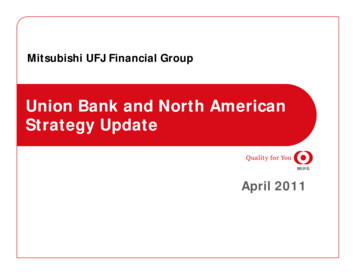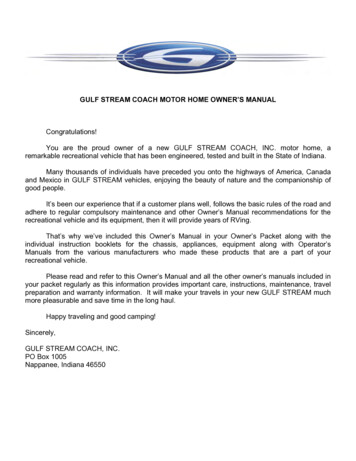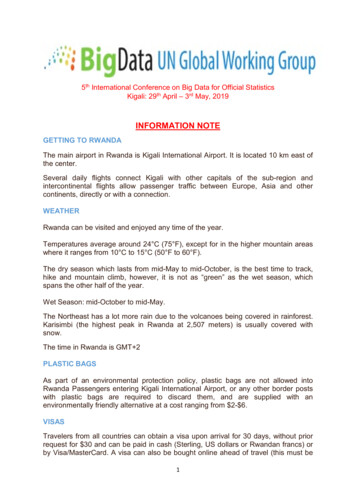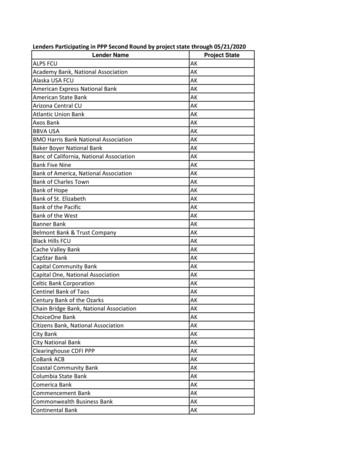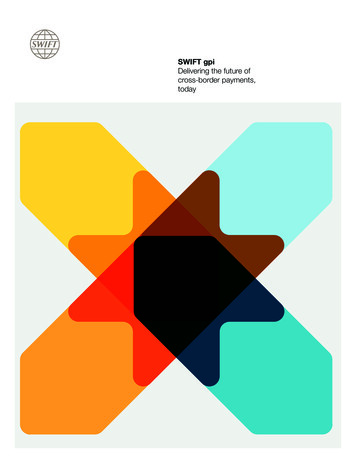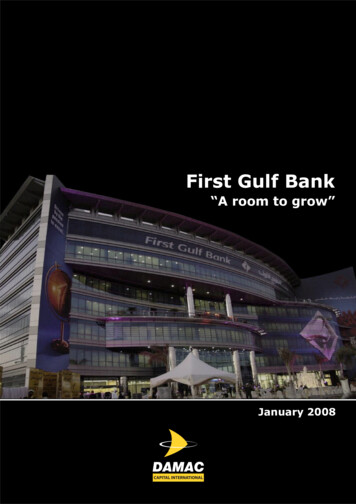
Transcription
First Gulf Bank“A room to grow”January 2008
First Gulf Bank (FGB)Key Data22.822.85 / 11.101,250Current Price (AED)*52 Week High - Low (AED)Number of Shares (Million)Fact Sheet200622.80 Country25.77 Sector13% ExchangeBank Financials (AED Mn)AssetsCash & InterbankInvestmentsLoans & Advances (Net)Fixed AssetsOthers AssetsTotal Assets2006 2007E2008E16,3839,799 11,7595,5117,2218,66525,16145,756 11110,39862,47574742888,158Liabilities & EquityDepositsInterbank LiabilitiesOther LiabilitiesMedium / Long Term LoansProvisionsTotal EquityTotal Liabilities & Equity2006 2007E2008E34,38448,138 89,76688,158Income Statement (AED Mn)Interest IncomeInterest ExpenseNet Interest ral & Admin ExpensesDepreciationOther ExpensesTotal Non-Interest 2)(856)(30)0(886)Provisions & TaxesMinority ationFGB.ADFGB DH28,50026%16.83.3Reuters CodeBloomberg CodeMarket Cap (AED bn)Free FloatP/E TrailingP/B TrailingValuationMarket PriceFair ValueUpside Potential2007E2008E2009ETotal Assets GrowthNet Loans GrowthTotal Deposit Growth82%85%98%34%82%47%15%14%19%20%20%24%Liquid Assets / Total AssetsNet Loans / Total DepsoitsCust. Deposits / Total Deposits46%73%99%27%90%94%28%86%95%28%83%92%Total Equity/Total AssetsTotal Equity/Net LoansCAR17%32%21%14%19%0%13%18%0%11%16%0%LLP/Gross LoansNPLs / Gross LoansNPLs Coverage RatioGross Loans/Cust. DepositsEarning Assets/Total 120%92%98%1.5%1.5%120%92%98%Net Interest MarginNet Non-interest MarginCost/IncomeInterest Income/Interest ExpenseInterest on Average Earning AssetsFunding CostInterest SpreadNet Profit 5.9%2.1%61%2.8%24.0%Performance of the stock Vs the ADSMI100%Fees & CommissionsInvestment IncomeOther IncomeTotal Non-Interest IncomeUAEBankingADSMBuyNet Attributable Income1,5361,683Shareholding StructureUAE Funds 4%2,0542,25880%60%FGB40%ADSMAS per the report first figureFree Float 26%20%Abu DhabiRuling Family60%0%/308Other Majorshareholders 10%1/3/20/2007079/3/20700/27/3203/5/11* As of 3.1.200807073/3/201/3/2007-20%First Gulf Bank2
Executive Summary As per 2006 figures, First Gulf Bank is the fourth largest bank in the UAE in terms of total assetswith 7% market share. In terms of deposits and loans, respectively, the bank is ranked third andhany.hussein@damacgroup.com fifth with a market share of 9.6% and 6.7%.VP - HEAD OF RESEARCHHANY HUSSEIN, CFASECTOR ANALYSTHANY SEIFhany.seif@damacgroup.com FGB has a network of 15 branches in the UAE in addition to 20 ATMs and 15 EDMs. Although thebank has focused on corporate business, recently it has increased its retail banking activity. Thebank also has diversified into new sectors including real estate development and management.The bank is setting up a commercial bank in Libya and is seeking a banking license in Algeria. The ruling family in Abu Dhabi Emirate owns 60% of the outstanding shares of FGB, which givesthe bank a rare opportunity to develop lucrative relationships with government-related clients. Fitch upgraded its credit rating for FGB from BBB Positive to A Stable. The upgrade reflectsFitch’s strong belief that FGB is very likely to garner the support of UAE authorities should theneed arise. Since 2003, the bank’s total assets have grown by a CAGR of 60% from AED 7 billion to AED47 billion. The bank grew rapidly partly because initially it was smaller than other banks in theUAE. However the major reason for its rapid growth was the large capital raise in 2005 whichgave the bank a large, interest-insensitive source of funding of AED 5 billion. Going forward, weconservatively expect to see assets grow by a CAGR of 18% until the end of our forecast periodin 2011. Most of the assets of FGB consisted of Loans & Advances and Due from banks. The ratio ofloans to total assets has declined from 71% in 2003 to only 51% in 2006. In fact, the bank wasnot able to grow its customer loans in line with deposits and other sources of funds. From 2003to 2006, loans grew by a CAGR of 68% while deposits grew by 80%. This explains why the bankhas a relatively low utilization ratio and why it has increased its lending to other banks. Goingforward, we expect the bank to grow its loans and deposits by 26% and 23%, respectively, duringthe forecast period. We also expect its utilization rate to improve from 73% in 2006 to reach 92%in 2011. FGB’s net income grew at an amazing CAGR of 133% from AED 181 million in 2003 to AED1.5 billion in 2006. During this period, the contribution of non-interest income to total operatingincome increased to reach 58% in 2006 at the expense of net interest income. Most of the increasecame in 2006 as the bank was granted a plot of land by the government of Abu Dhabi. Additionalgains resulted from a re-evaluation of real estate assets. Conservatively, we expected net incometo grow by CAGR of 12% to reach AED 2.65 billion by 2011. As of 2006, FGB was well-capitalized with a Capital Adequacy Ratio (CAR) of 21%. This affectedthe bank’s Return on Equity (18.3%) although the bank reported the highest Return on Assets(4.1%) among its peers according to Bloomberg. We expect the bank to reduce its CAR in thefuture through the exploration of investment opportunities. We valued the bank using a combination of Discounted Cash Flow to Equity and MultiplesMethods. We assigned a weight of 80% to the cash flow and 20% to book value method, whichgenerated a fair market value of AED 25.77 per share with an upside potential of 13% comparedto the current market’s price. Hence, we initiate our coverage on FGB with positive outlook and Buy recommendation asthe bank gives investors a good opportunity to have an exposure to the UAE fast growing sectorthrough one of the aggressive and well capitalized banks, with an upside potential of 13%.First Gulf Bank1
Contents Bank Overview3 Lines of Business5 Financials7 Valuation14First Gulf Bank2
Bank OverviewFirst Gulf Bank (FGB) was established in 1979 and headquartered in Abu Dhabi. Since October1996, a majority of the shares have been owned by the Al-Nahyan family, the ruling family of AbuDhabi. The bank, which has focused on corporate banking, has benefited from lucrative contractswith state-owned, corporate clients. Recently, it has become more active in retail business wherefunds are cheaper. The management also is focusing on new lines of business such as treasuryand investment services in an attempt to augment its non-interest revenues and to diversify itsincome.First Gulf Bank has a network of 15 branches in addition to 20 ATMs and 15 EDMs concentratedin Abu Dhabi, Dubai, and Sharjah. The bank has strengthened its position in the retail market byadding 3 branches to its network by end of 2007. The bank employs 780 people in addition to1,200 outsourced sales agents for retail products.Lower quality ofassets triggered arestructure in the1990sDuring the 1990s, FGB experienced a number of financial problems caused by the poor quality ofits assets. These problems encouraged the largest shareholder to restructure the managementwhich brought a former Citi Bank management team on board.In 2006, themanagementdoubled the bank’sassets, loans, anddespotsIn 2006, FGB grew more quickly than any UAE bank. Its assets, loans, and deposits grew by 82,83, and 99%, respectively, and its net income grew by 46%. Although FGB has reported a strongReturn on Average Assets of 4.1%, this failed to fuel an increase in Return on Investment due toits high capital adequacy ratio and relative low equity multiplier compared to other banks.To stimulate further growth, FGB introduced investment banking services in 2001 and retailbanking in 2002. In 2005, the strong performance of the secondary market as well as investors’appetite for IPOs encouraged all UAE companies to raise capital regardless of the need for it. FGBraised equity of almost AED 5 billion – more than any other UAE bank – through bond conversionand rights issue. Almost AED 800 million was converted from debt to 93 million shares. In addition,502 million new shares were introduced, which increased the total number of outstanding sharesto 1,250 million. This conversion gave the ruling family 60% of the bank’s ownership and signaledthe confidence of the shareholders in plans for expansion.For two successive years, FGB has been nominated as the fastest growing bank in the world.Among UAE banks, FGB is sixth largest in terms of equity and reported profits and seventh largestin terms of assets.It seems that 2007 has been another outstanding year for FGB. On a year over year basis, total2007 is anotheroutstanding year for assets grew by 71%, during the first nine months of the year, to reach AED 62 billion. Loans andadvances grew by 80% to reach AED 40 billion and deposits grew by 94% to reach AED 45 billion.the bankOn the profitability side, the bank has reported a net income for the same period of AED 1.11billion, which represented growth of 22% on a year over year basis.First Gulf Bank3
The Ruling familyof Abu Dhabi owns60% of the bank’soutstanding sharesThe ruling family in Abu Dhabi owns 60% of the bank, which helps the bank gain the lucrativecontracts with most of state-owned companies. The free float stands at approximately 26%, whilethe remainder represents ownership by other shareholders. It is worth mentioning here that due tothe fact that the ruling family owns a majority of shares ensures that FGB is highly rated by ratingagencies. Fitch recently has affirmed the rating of the bank at ‘A’ with an outlook of “stable”.Figure1: Ownership Structure - 2007UAE Funds 4%Free Float 26%Abu Dhabi RulingFamily 60%Other Major shareholders10%Source: Damac & FGBFitch upgraded itsrating for FGB fromBBB Positive to A Stable. The Upgradereflects Fitch’sbelief that FGBwould like to getany support fromUAE authoritiesshould the needarisesQualitatively, Fitch upgraded its credit rating for FGB from “BBB with Positive outlook” to “A with Stable outlook”. The upgrade reflects Fitch’s strong belief that FGB is almost certain to garnerthe support of the UAE authorities should the need arise. This belief is affirmed by the long historyof the UAE authorities’ support of its banks and by the stake in the bank of the ruling family ofAbu Dhabi. Quantitatively, the “Stable outlook” reflects the bank’s improved performance in 2006and H1 2007. During that period, year over year growth of net income was 22%. In addition, thequality of assets was high. Non-performing loans were as low as 1.5% and the coverage ratio wasgreater than 100%. The rating also reflects the bank’s strong capitalization. As of 2006, its CapitalAsset Ratio was 21%.FGB’s increased tolerance of market risk can be deduced from its investments in the real estatesector as well as its increased investment in securities. Furthermore, the current turmoil in theinternational financial markets has had little effect on the bank. Large deposits from state-ownedcompanies and other government-related customers remain the vast majority of FGB’s fundingresources, which also contributed to Fitch’s “Stable outlook” rating.First Gulf Bank4
Lines of Buisness (LOBs)Corporate BankingCorporate banking group offers financial services for medium to large corporations. The groupfocuses on oil & gas, manufacturing, energy and real estate. It has in its fold the following units: Institutional Banking: main focus is on financial institutions, international and region syndications,structured deals, Initial Public Offerings (IPOs) Private Banking Group: offers customized and diversified range of products in Real Estate,Funds, and Equities. Islamic Banking: offers all types of Islamic financing and investment products including Murabaha,Ijara, and Mudaraba.The corporate banking group in FGB is involved increasingly in financing the numerous powerand construction projects in the UAE, particularly in Abu Dhabi. In addition to the usual corporateactivities, FGB maintains a division responsible for lending to small and medium enterprises (SME).Going forward, corporate banking activities are expected to be the largest contributor to FGBoperating income.FGB is getting moreexposed to the Realestate sectorUnder the umbrella of Corporate Banking, FGB established its real estate department. Thedepartment’s main areas of activities include real estate management, leasing, accounting,maintenance and advisory services. It also slated to design, develop, and sell real estate projectsin Abu Dhabi and Dubai. After establishing a track record in the real estate sector, FGB establishedsome companies that focus on business development and property management. We believethat the bank will spin off its real estate business as a separate vehicle. The move will follow thedecision of the UAE central bank to permit the banks to take up real estate subsidiaries. Among theFGB’s announced projects are Burj Al Noujoum which consists of 30 floors and 395 units and theWestbury Square with total investments of AED 600 million comprising commercial and residentialunits at the Business Bay in Dubai.Treasury &Investment BankingGroupThe Treasury and Investment banking group provides the following products: Foreign exchange & money markets Derivatives and structured products Local and international equity brokerage Selling international funds and private equity Bonds/fixed income instruments Proprietary local & international portfolio Portfolio managementFGB is seeking to increase its treasury fee income through providing new products and services toits corporate customers. In 2006, FGB sold a stake of 35% in First Gulf Financial Services with asubstantial gain of AED 98 million to a number of the ruling family members, signaling a decreasein the contribution of brokerage income to the operating income of the bank.Retail BankingRetail banking focuses on offering mortgages and personal loans to UAE nationals. Recently, loanshave been extended to expatriates and women. Current and savings accounts are also offered topenetrate the funding base of the retail sector.Figure 2: Contribution of different business segments 9M0760%50%Corporate Banking40%Treasury30%Retail Banking20%10%0%SubsidiariesAssetsOperating IncomeNet ProfitSource: Damac & FGB FinancialsFirst Gulf Bank5
Bank subsidiariesIn addition to its main groups, FGB’s investments in associates include the following subsidiaries: First Gulf Financial Services Company (45%) Green Emirates for property management and brokerage (40%). Other shareholders includeAl Dar properties, Sorouh properties, and Reem Investments Aseel Finance for Islamic Mortgage Finance (40%) First Merchant International (100%) Mismak Property Development Company (100%)FGB’s StrategyA major financial goal of First Gulf Bank is to achieve carefully planned, consistentgrowth. To do that, the bank will continue to serve corporate clients as well as individualsof high net-worth while simultaneously opening additional branches to expand its retailbanking network. The bank will continue to capitalize on inexpensive sources of fundsas well as lucrative investment opportunities with government-related clients throughits relationships with the Al-Nahyan family.The management of the bank is aware that the banks’ Capital Adequacy Ratio, whichis somewhat high, has the potential to affect the bank’s performance. However, thebank has access to governmental support if the need arises. Maintaining a high CapitalAdequacy Ratio and a concomitantly low Equity Multiplier reduced the bank’s Return onEquity in 2006, although its Return on Assets was the highest among its peers. In thefuture, we expect to see additional growth in balance sheet items and hopefully withoutan increase in capital.FGB is being re-structured to become a full fledged financial group. The bank’sdiversification strategy focuses on establishing several subsidiaries covering differentlines of business such as property management, real estate development, Islamicfinancing, and merchant banking. Diversification will continue to be an underlying ethosof the bank and will extend not only to products and services but also to its geographicfootprint as the bank will expand regionally as well as internationally.First Gulf Bank6
FinancialsBank’s total assetswas almost doubledin 2006 to reachAED 48 billionFGB is considered the first bank in the world in terms of growth. Since 2003, the bank’s assets havegrown at a cumulative annual growth rate of 60%, increasing from AED 7 billion to AED 47 billion.In 2006 alone, the bank’s assets almost doubled. The rapid growth of the bank can be explainedpartly by its small base relative to its peers. However the main driver underlying its growth hasbeen the large capital raise in 2005, which had given the bank a large, interest-insensitive sourceof funding of AED 5 billion.Figure 3: Growth in Assets vs. Total AssetsAED 12.71020%7.2020032004200520060%Source: Damac & FGB FinancialsHow did FGB investits assets?When capital is raised, the performance of a bank’s management team can suffer because timeand energy is diverted into assuring that the new resources are used efficiently. Consequently, thedecision to raise capital can be of concern to shareholders. This happened to FGB in 2005 whenmanagement raised AED 5 million of new capital. Total loans and advances (the main interestearning asset) increased from AED 14 billion in 2005 to AED 26 billion. However, the rate of growthin loans declined from 128% (2004) and 104% (2005) to only 84% in 2006. Loans and advancesdeclined to only 51% of total assets in 2006 compared with 71% in 2003.Figure 4 (Right): Asset Allocation in %Figure 5 (Left): Loans Vs. Growth in Loans.AED 20042005Loans & AdvancesSource: Damac & FGB 05CashMarketable SecuritiesOther Assets2006Due From BanksLoans & AdvancesFirst Gulf Bank7
To utilize the capitalit had raised, FGBlent to other banksaggressively, takingdues from banks to25% of total assetsFrom 2003 to 2006, FGB increased its lending to other banks from 7% to 25%, although theinterest rate on loans to commercial banks is lower than the rates on customer loans. This raises aquestion as to whether it was necessary for FGB to raise capital in 2005 or whether the bank wassimply following a trend fueled by the heated stock market of 2005. In 2006, the bank’s utilizationrate (the ratio of loans to customer deposits) was only 74%, which is significantly lower than itshistorical levels and lower than that of other banks.Figure 6: Loans to Deposits ratioAED 20060%Source: Damac & FGB FinancialsLoans PortfoliobreakdownFGB’s lending to the real estate and construction sector almost tripled from 2005 to 2006, increasingfrom AED 2 billion to AED 5.7 billion. The sector represented 22% of total loans in 2006 comparedwith only 14% the year before. This increase came partially at the expense of the personal loansegment which declined from 30% to 23% of total loans. The bank also reduced its lending to theshare financing segment during the same period due to unfavorable conditions in local markets.Figure 7 (Right): Loans breakdown 2005Figure 8 (Left): Loans breakdown 2006Services 14%Share Financing 8%Share ersonal(Retail &(Retail & Others) 30%Others) 23%Real Estate & ConstructionReal Estate &22%Construction14%Source: Damac & FGB FinancialsFirst Gulf Bank8
How did FGBFinance its Assets?Customer deposits contributed 72% of the bottom line in 2006 compared with 66% in 2005. Ingeneral the bank did extremely well in growing its customer deposits, which increased from AED6 billion in 2003 to reach AED 34 billion in 2006 (a CAGR of 54%). Money Market deposits or duesfrom banks represented less than 1% of total assets. In fact, FGB is a new lender to other banksrather than a borrower.Figure 9 (Right): Deposits Vs Growth in DepositsFigure 10 (Left): Liability allocation in %80%70%60%50%40%30%20%10%0%AED 00420052006DepositsLoans & MTLsOwners EquityDue to other banks0120%20032004Customer Deposits200520060%Growth RateSource: Damac & FGB FinancialsIn 2003, time deposits represented more than 90% of the total deposits (Fig. 12, left). Theremaining 10% consisted of savings deposits and demand deposits. The charts below also indicatethat each of the three types of deposits almost had the same share to total deposits from 2003to 2006.Figure 11 (Right): Deposits breakdown 2006Figure 12 (Left): Deposits breakdown 2003Time DepositsTime Deposits90%92%Savings Deposits1%DemandDemandDeposits 9%Deposits 7%SavingsDeposits 1%Source: Damac & FGB FinancialsFirst Gulf Bank9
By 2009, FGB willhave paid its loansAs of 2006, FGB had two loans worth AED 4 billion. Loans as a funding source for assets increasedfrom just 2% to 9%. In 2004, the first loan (USD 175 million), which was made to a syndicatecomprising several foreign banks, is repayable in full in November 2007. The loan accrues interestat the rate of LIBOR plus a margin of 0.4% per annum, which is payable semiannually. In 2006, asecond loan (USD 750 million) was made to syndicate comprising several foreign and local banks.It is repayable in full in March 2009. The loan accrues interest at the rate of LIBOR, plus a marginof 0.3%, plus mandatory costs calculated by the Facility Agent as a weighted average of thelender’s additional cost rates, which are payable semiannually.Owners equity is thesecond source offunding for assetswhich reducesthe overall cost offundingOwners’ equity, which is the second largest source of funding after customer deposits, stood at17% of total assets as of 2006. Before the capital raise of 2005, owners’ equity comprised 29%of total assets. From 2003 to 2006, the Capital Adequacy Ratio also declined from 37% to 21%.It seems that the bank remains overcapitalized and will need more time to fully utilize its capital.FGB is setting a commercial bank in Libya, and is also seeking a commercial banking license inAlgeria.Having much larger pool of capital than the minimum required by the regulatory body allows thebank to have a lower effective funding cost. In 2006, the funding cost (excluding equity) was 6%.If we include equity, which is not an interest-bearing source, the effective cost would decline to4.7%.FGB has sufficientliquid assets toensure that allfinancial obligationswill be met whenthey are dueFor a bank, liquidity means the ability to meet its financial obligations as they come due. Lendingallows a bank to invest in relatively illiquid assets but a bank funds its loans mainly with shortterm liabilities. Thus, one of the main challenges to a bank is to ensure its own liquidity under allreasonable conditions. In case of FGB, the bank enjoys considerable liquidity. The proportion ofassets that are liquid has improved from 28 to 46% during the period from 2003 to 2006. Also,the ratio of total liquid assets to total deposits has increased from 34% to 64% during the sameperiod. Bank liquidity risk can be increased by market disruptions or by a credit downgrade, whichmay immediately reduce the availability of funds. FGB mitigates such risk as its managementdiversified funding sources and maintained a healthy balance of cash, cash equivalents, and readilymarketable securities. In the case of FGB, liquidity risk is only a minor concern because the rulingfamily of Abu Dhabi controls 60% of the bank’s outstanding shares. This makes us quiet sure thatthey will certainly intervene if any need arises.Figure 13: Liquid Assets to total Assets & 34%28%0%20032004Liquid assets/Total assets20052006Liquid assets/Customer DepositsSource: Damac & FGB FinancialsFirst Gulf Bank10
Liquidity risk may be affected as well by the mismatch of due assets and liabilities. The contractualmaturities of assets and liabilities is being determined on the basis of the remaining period atthe balance sheet date to the contractual maturity date and do not take account of the effectivematurities as indicated by the Bank’s deposit retention history and the availability of liquid funds.FGB short term deposits, less than a year, amounted to 99.9% of total deposits in 2005 whileloans of the same maturity reached 54.1% for the same year. In 2006, deposits due in less thana year amounted to 85.4% of total deposits, while corresponding loans of same maturity reached55.6%. The maturity gap between loans and deposits are supported by a strong liquid position asillustrated above.Figure 14: Maturity of Loans & %0% 1With low NPLs andmore than 100%coverage, FGB’sassets enjoy highdegree of qualityDeposits56%54% 1 1 1Non Performing Loans (NPLs) as a percentage of gross loans have improved from 6.14% as of2003 to 1.8% as of 2006. The management of FGB made sure to create enough provision for thenon performing loans which stood at 100% as of 2006.Figure 15: NPLs/ Gross Loans Vs. provisions for 0%1%20%0%2003200420052006Coverage RatioNPLs/Gross LoansLLP/Gross Loans0%Source: Damac & FGB FinancialsFirst Gulf Bank11
IPO funding had apositive impact onthe spread during2005 and 2006FGB cost of funding witnessed steady increases from 0.74% in 2003 to 2.05% in 2004 and 6.98%in 2005 before it declined back in 2006 to reach 5.96%. IPO funding related expenses represented62% and 21% of the total interest expense in 2005 and 2006. On the other side, IPO fundingrelated interest income represented 52% and 21% of the total interest income during the sameperiod. Figure 16 and 17 show the impact of IPO funding business on the bank’s spread. It isillustrated that IPO funding helped the bank to achieve higher spread of 2.93% rather than 2.10%only in 2005 and 1.96% rather than 1.84% in 2006. Going forward, we expect that the bank willbe able to sustain its spread at 2%.Figure 16 (Right): Spread (Excluding IPO related interest expenses and income)Figure 17 (Left): Spread (Including IPO related interest expense and rest On Average Earning AssetsFunding CostSpread200420050%2006Interest On Average Earning AssetsFunding CostSpreadSource: Damac & FGB FinancialsThe cumulativeannual growth rateof Net InterestIncome was 62%From 2003 to 2006, FGB’s interest income increased at a CAGR of 90%, from AED 223 million toAED 2.9 billion. Net interest income increased at a CAGR of 62% from AED 176 million to reachAED 1.2 billion. Most of the income derived from IPO funding activity was classified under interestincome as IPO funding related interest income. In 2005, more than half of the total interest incomecame from IPO funding. From 2004 to 2006, interest income increased almost 4 fold, but in 2006,the year over year increase in total interest income was only 52%, as the contribution from IPOfunding interest income declined to 21%. With the recovery in the local stock exchanges, weexpect more IPO activity in 2008 and 2009 which will have a positive impact on the income streamof the bank.Figure 18: Interest income 2003-2006AED mn3,0002,500Total InterestIncome2,000Interest1,500Expense1,000Net Interest5000Income2003200420052006Source: Damac & FGB FinancialsFirst Gulf Bank12
Since 2003, Noninterest incomegrew by CAGR of109%. reaching58% of totaloperating incomeIn 2006, 58% of the bank income came from non core business. Since 2003, the contribution ofnon core business - as percentage of total operating income - has been growing steadily at theexpense of the core banking from 21% to 58%. We expect this trend to continue as the bank isdiversifying its business lines into other business segments such as real estate development andmanagement.In 2006, other income increased from AED 58 million to AED 541 million representing 26% of thebank total operating income. Other income increased tremendously due to three main effects; firsta plot of land was granted by the Government of Abu Dhabi and stated at fair value of AED 165million based on an independent professional valuation. Second; A amount of AED 177 million asa gain on revaluation of investment properties, and finally; an amount of AED 98 million as a gainon a partial sale of its brokerage arm, First Gulf Financial Services LLC, in which FGB sold 43.75%of its 80% shareholding.Figure 19 (Left): Core Vs. Non Core income (2003 -2006)Figure 20 (Right): Breakdown of Non Core income in 200680%70%60%50%40%30%20%10%0%AED mn60078%58%50040042%30020021%20031002004Net Interest Income2005200602003Non Interest IncomeSource: Damac & FGB FinancialsDue to significantincome from IPOactivity, investmentincome, and nonrecurringiterm, FGB looksmore efficient200420052006Fees & commissionsInvestment IncomeOther IncomeThe bank’s ratio of cost to income declined from 42.3% and 28.3% in 2003 and 2004, to 16.4%and 19.3% in 2005 and 2006 respectively. The improvement can be explained by two factors. First,economies of scale were achieved as the bank has grown over the last few years, making fixedexpenses less visible compared to the income generated from a bigger balance sheet. Second,the bank started to book new kinds of
First Gulf Bank has a network of 15 branches in addition to 20 ATMs and 15 EDMs concentrated in Abu Dhabi, Dubai, and Sharjah. The bank has strengthened its position in the retail market by adding 3 branches to its network by end of 2007. The bank employs 780 people in addition to 1,200 outsourced sales agents for retail products.





